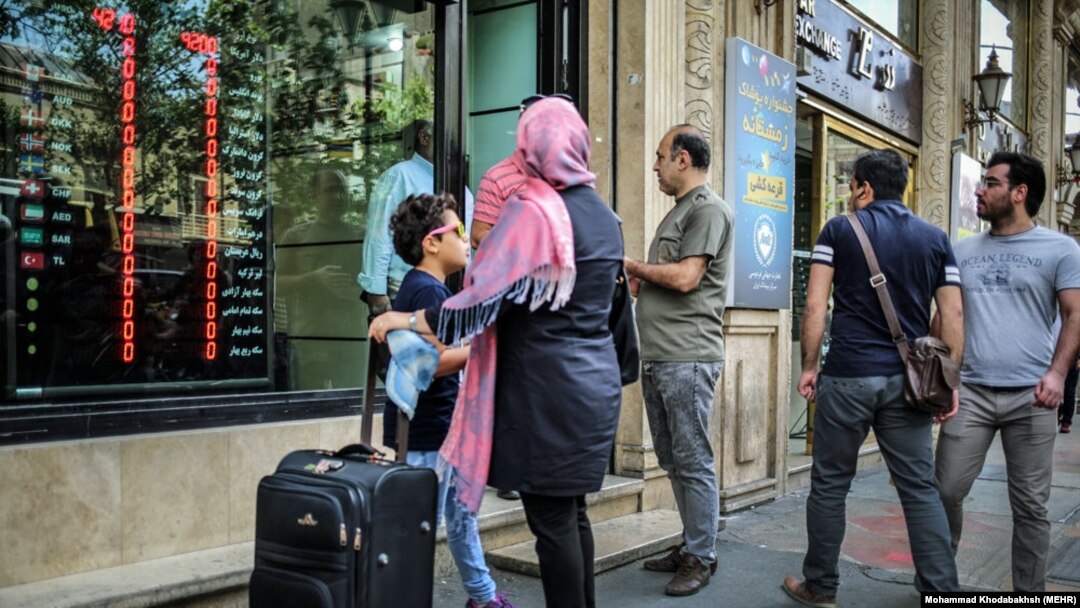Every day, hundreds head to Tehran's bustling Ferdowsi street to buy foreign currency, only to find that many exchange offices have shut up shop, have turned off their currency-rate displays, or have signs up reading, "We don't have U.S. dollars to sell."
A nationwide dollar-buying panic is in full swing, spurred by the plunging value of the Iranian rial, a sluggish economy, and fears that the United States will reimpose crippling sanctions on the Islamic republic.
With the rial hitting all-time lows, the government has imposed an official exchange rate of 42,000 rials against the dollar, set a cap on the amount of foreign currency that citizens can hold outside banks, and sent police to patrol exchange shops to ensure that no under-the-table currency trading is going on.
But economists say the new currency measures will be difficult to maintain. Exchangers are hoarding U.S. dollars, and Iranians who require foreign hard currency for business or travel are already defying the government and turning to the black market, where the rate has skyrocketed.
"A few days ago, I went to several exchange offices to buy $300," a Tehran businessman who did not want to reveal his name told RFE/RL's Radio Farda. "But I couldn't even purchase $100. So I was forced to buy several hundred dollars on the black market. I paid 58,000 rials for $1."
The businessman said exchange offices had U.S. dollars to sell, but would not do so for the government's set rate of 42,000 rials. Instead, he said, exchangers were still selling dollars for free-market exchange rates, despite Tehran's warning that those caught trading foreign currency outside official rates would face arrest.
"The currency crisis has made us poor," he said. "But I have an import business so I need to buy American dollars otherwise I can't continue my work."
'We Weren't Prepared For This'
The new measures are affecting Iranians who study, travel, or do business abroad, as well as those who keep their savings in dollars.
"My family sent my brother to study overseas," a young Iranian man told Radio Farda on condition of anonymity. "The day he left, the [free-market] exchange rate was 35,000 rials to every dollar. Now, unfortunately, the dollar has reached 60,000 rials."
"Now, we can't afford to send him money anymore," the young man said, adding that "we weren't prepared for this."
Police patrol exchange shops to ensure that no under-the-table currency trading is going on.
President Hassan Rohani, who was elected to a second term in 2017 on pledges to boost jobs and the recession-hit economy, has been under fire. In January, grievances against the government spilled over into antigovernment protests across Iran. The demonstrations were crushed, leaving at least 25 people dead.
"One of the reasons I voted for Rohani was because I thought he would improve the economy," the young man said. "But in the last few months we have seen, unfortunately, that the administration doesn't have the necessary policies or ability to improve the economy."
'Perfect Currency Storm'
Iran's currency has lost close to half its value on the free market since September, when the dollar was at 36,000 rials. The currency hit a record low of 60,000 on the free market last week.
Steve Hanke, an economist teaching at Johns Hopkins University in Baltimore, says economic mismanagement and residual international sanctions on Iran have worked to "create a perfect currency storm."
Iran has been unable to reap the full benefits of the 2015 nuclear deal with world powers -- under which Tehran curbed its contentious nuclear program in exchange for sanctions relief.
This is partly due to resistance among Iran's hard-line conservative camp to opening up the state-controlled economy, residual U.S. sanctions linked to Iran's human rights record and ballistic-missile program, and European companies' continued wariness of investing in Iran because of fears of U.S. penalties. Economists say this has severely affected Iran's access to trading relationships, finance, and foreign investment.
Valiollah Seif, the current governor of the Central Bank of Iran, has blamed "enemies" and "traces of plotting."
The spiraling currency has also been driven by fears of a return of crippling sanctions if U.S. President Donald Trump carries out his threat to exit the nuclear deal with Tehran.
Iran has long had trouble managing its currency market. In 2012, the government tried to set an official, single, rate for the currency, but the attempt failed.
"The new currency system is bound to fail," Hanke says. "Iranians will continue to flock to the black market for the safety of foreign currency. Also, no economy has ever been given life by devaluations."
"The currency crisis will not stimulate exports and it will not stimulate domestic production either," he adds. "The weak rial will be associated with higher interest rates and more inflation, however."
'Economic War'
Rohani's government has deflected blame for the currency crisis on detractors at home and abroad. Government spokesman Mohammad Baqer Nobakht said on April 10 that Iran was in an "economic war, and enemies seek to create problems for our economy."
The head of Iran's central bank, Valiollah Seif, was met with angry objections and interruptions from lawmakers in parliament last week, with many demanding his resignation.
Seif blamed the plunging value of the rial on "lack of certainty" about the future and said that "enemies know the issue and try to use any opportunity" to create trouble for Iran. He also referred to "traces of plotting" by regional rivals, including Saudi Arabia and the United Arab Emirates, without elaborating.
Vice President Eshagh Jahangiri blamed "noneconomic, unjustified, and unpredictable factors" for the rial's collapse, given that he said the country's exports were performing strongly.
"There should not be such incidents in an economy that always has a surplus of foreign currency. Some say interference by foreign hands is disrupting the economic climate and some say domestic machinations are spurring these things in order to destabilize the climate in the country," Jahangiri added.


